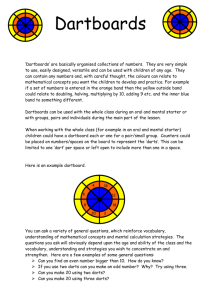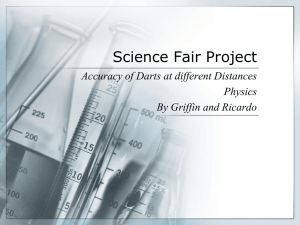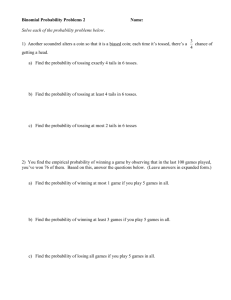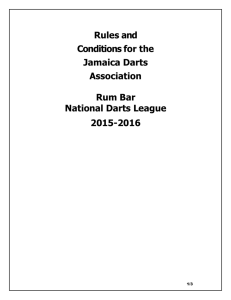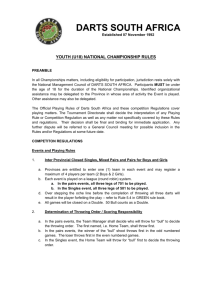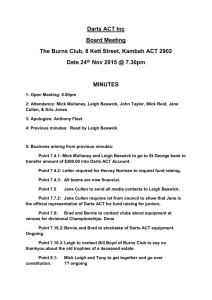Measuring the distance of generalized maps - LIRIS
advertisement
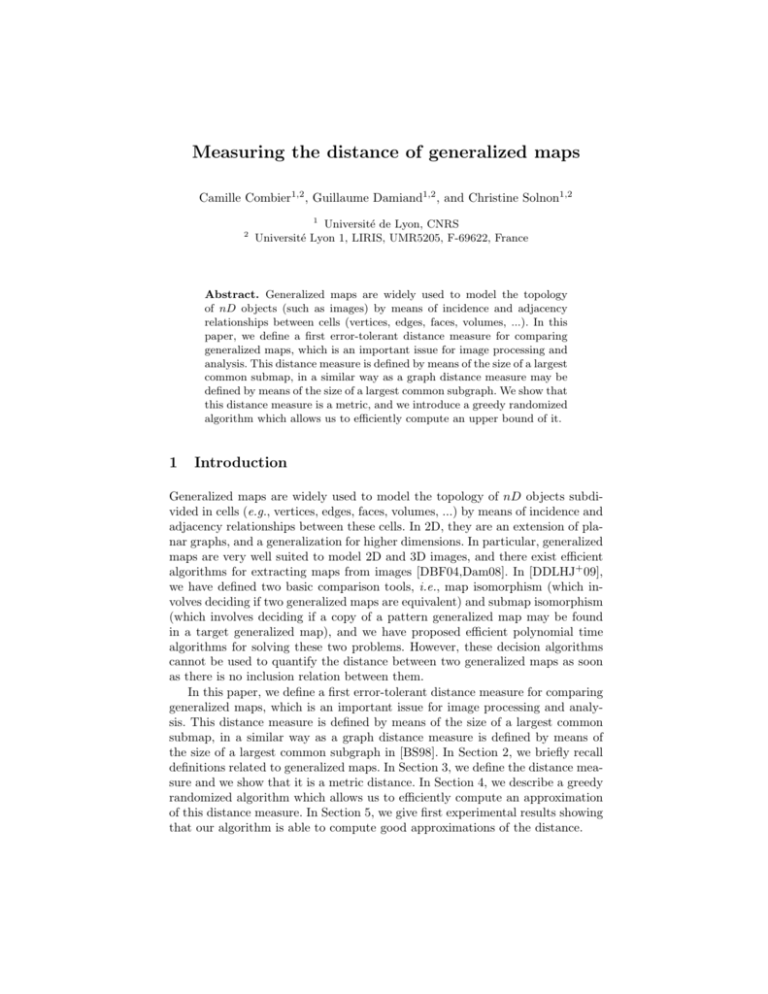
Measuring the distance of generalized maps
Camille Combier1,2 , Guillaume Damiand1,2 , and Christine Solnon1,2
1
2
Université de Lyon, CNRS
Université Lyon 1, LIRIS, UMR5205, F-69622, France
Abstract. Generalized maps are widely used to model the topology
of nD objects (such as images) by means of incidence and adjacency
relationships between cells (vertices, edges, faces, volumes, ...). In this
paper, we define a first error-tolerant distance measure for comparing
generalized maps, which is an important issue for image processing and
analysis. This distance measure is defined by means of the size of a largest
common submap, in a similar way as a graph distance measure may be
defined by means of the size of a largest common subgraph. We show that
this distance measure is a metric, and we introduce a greedy randomized
algorithm which allows us to efficiently compute an upper bound of it.
1
Introduction
Generalized maps are widely used to model the topology of nD objects subdivided in cells (e.g., vertices, edges, faces, volumes, ...) by means of incidence and
adjacency relationships between these cells. In 2D, they are an extension of planar graphs, and a generalization for higher dimensions. In particular, generalized
maps are very well suited to model 2D and 3D images, and there exist efficient
algorithms for extracting maps from images [DBF04,Dam08]. In [DDLHJ+ 09],
we have defined two basic comparison tools, i.e., map isomorphism (which involves deciding if two generalized maps are equivalent) and submap isomorphism
(which involves deciding if a copy of a pattern generalized map may be found
in a target generalized map), and we have proposed efficient polynomial time
algorithms for solving these two problems. However, these decision algorithms
cannot be used to quantify the distance between two generalized maps as soon
as there is no inclusion relation between them.
In this paper, we define a first error-tolerant distance measure for comparing
generalized maps, which is an important issue for image processing and analysis. This distance measure is defined by means of the size of a largest common
submap, in a similar way as a graph distance measure is defined by means of
the size of a largest common subgraph in [BS98]. In Section 2, we briefly recall
definitions related to generalized maps. In Section 3, we define the distance measure and we show that it is a metric distance. In Section 4, we describe a greedy
randomized algorithm which allows us to efficiently compute an approximation
of this distance measure. In Section 5, we give first experimental results showing
that our algorithm is able to compute good approximations of the distance.
2
C. Combier et al.
b
p
c
i
d o
a
j
e n
h
g
f
k
m
ab c
α0 h c b
α1 b a d
α2 a b c
d
e
c
o
e
d
f
n
f
g
e
f
g
f
h
g
h
a
g
h
i
p
j
i
j
k
i
j
k
j
l
k
l
m
k
l
m
l
n
m
n
o
m
e
o
n
p
d
p
i
o
p
l
Fig. 1. Example of 2G-map: consecutive darts separated with a little segment are 0sewn (e.g., b and c); consecutive darts separated with a dot are 1-sewn (e.g., a and b);
parallel darts are 2-sewn (e.g., d and o); a is 2-free because α2 (a) = a.
2
Generalized maps and (sub)map isomorphism
Let us first recall basic definitions on generalized maps, which are a generalization
of combinatorial maps. We refer the reader to [Lie94] for more details.
Definition 1 (nG-map) Let n ≥ 0. An n-dimensional generalized map (or nGmap) is defined by a tuple M = (D, α0 , . . . , αn ) such that (i) D is a finite set of
darts; (ii) ∀i ∈ [0, n], αi is an involution3 on D; and (iii) ∀i, j ∈ [0, n] such that
i + 2 ≤ j, αi ◦ αj is an involution.
We will say that a dart d ∈ D is i-free whenever d = αi (d), and that it is i-sewn
to d0 ∈ D whenever d = αi (d0 ) and d 6= d0 . Fig. 1 displays an example of 2G-map
which describes an object composed of two adjacent faces.
Map isomorphism checks for the equivalence of nG-maps. It has been defined
in [Lie94]. Submap isomorphism checks for the inclusion of two nG-maps. It has
been defined in [DDLHJ+ 09] for combinatorial maps. Definition 2 extends this
definition to generalized maps (see Fig. 2 for an example).
Definition 2 (nG-map subisomorphism) Let M = (D, α0 , . . . , αn ) and M 0 =
(D0 , α00 , . . . , αn0 ) be two nG-maps. M is subisomorphic to M 0 , denoted M v M 0
if there exist an injective function f : D → D0 such that ∀d ∈ D, and ∀i ∈ [0, n]:
– if d is i-sewn, then f (αi (d)) = αi0 (f (d));
– if d is i-free, then either f (d) is i-free, or f (d) is i-sewn with a dart which
is not matched by f to another dart of D, i.e., ∀dk ∈ D, f (dk ) 6= αi0 (f (d)).
3
Definition of a distance measure for generalized maps
Submap isomorphism may be used to decide of generalized map inclusion, but
it cannot be used to quantify the distance between two nG-maps which are not
related by an inclusion relationships. In this section, we propose to quantify
this distance by means of the largest generalized map included into the two
generalized maps to be compared. This definition may be viewed as an extension
of the graph distance measure based on maximum common subgraphs defined
in [BS98].
Let us first define generalized map sizes and maximum common submaps.
3
An involution f on D is a bijective mapping from D to D such that f = f −1 .
Measuring the distance of generalized maps
a
t
b
i
o n
s
r
c
j g
p m
q
h
l
k
f
d
9
e
10
2
1
5
6
8 3
7 4
11
(a) M
(b) M 0
1→b
4→m
7→p
10 → r
2→a
5→l
8→o
11 → q
3
3→n
6→k
9→s
(c) Subisomorphism function f
Fig. 2. Submap isomorphism example: f is a subisomorphism function from M 0 to M .
Definition 3 (size of an nG-map) The size of an nG-map M = (D, α0 , . . . , αn )
is denoted |M | and is defined by its number of darts, i.e., |M | = |D|.
Definition 4 (maximum common submap) Let M and M 0 be two nG-maps. A
maximum common submap of M and M 0 , denoted mcs(M, M 0 ), is an nG-map
such that mcs(M, M 0 ) v M , mcs(M, M 0 ) v M 0 ; and |mcs(M, M 0 )| is maximal.
Note that mcs(M, M 0 ) is not necessarily unique as there may exist several
common submaps which have a same size. A maximum common submap basically corresponds to the intersection of two nG-maps, and its size may be used
to quantify their similarity: the larger a maximum common submap, the more
similar the two nG-maps. To define a distance, we normalize this size with respect to the size of the largest of the two generalized maps, as proposed in [BS98]
for graphs.
Definition 5 (distance between two nG-maps) Let M1 and M2 be two nG-maps.
The distance between M1 and M2 is defined by:
d(M1 , M2 ) = 0
d(M1 , M2 ) = 1 −
|mcs(M1 ,M2 )|
max(|M1 |,|M2 |)
if |M1 | = |M2 | = 0;
otherwise.
Theorem 1 Let n ≥ 1. The distance d is a metric on the set M of all nG-maps
so that the following properties hold:
1. Non-negativity: ∀M1 , M2 ∈ M, d(M1 , M2 ) ≥ 0;
2. Isomorphism of indiscernibles:
∀M1 , M2 ∈ M, d(M1 , M2 ) = 0 iff M1 and M2 are isomorphic;
3. Symmetry: ∀M1 , M2 ∈ M, d(M1 , M2 ) = d(M2 , M1 );
4. Triangle inequality: ∀M1 , M2 , M3 ∈ M, d(M1 , M3 ) ≤ d(M1 , M2 )+d(M2 , M3 ).
Proof. Properties 1, 2, and 3 are direct consequences of Def. 5.
Let us denote mij = mcs(Mi , Mj ), and Sij = max(|Mi |, |Mj |), and let us show
Property 4 by considering separately the two following cases.
(Case 1): d(M1 , M2 ) + d(M2 , M3 ) ≥ 1.
In this case, the triangle inequality trivially holds as d(M1 , M3 ) ≤ 1.
(Case 2): d(M1 , M2 ) + d(M2 , M3 ) < 1.
In this case, let us first show that there exists at least one dart d of M2 which
4
C. Combier et al.
belongs both to m12 and m23 or, in other words, that the sum of the number of
darts of m12 and m23 is strictly greater than the number of darts of M2 so that
at least one dart of M2 belongs to the two common submaps, i.e.,
|M2 | < |m12 | + |m23 |
(1)
This inequation can be proven by considering all possible order relations between
nG-map sizes. For example, if |M1 | ≥ |M3 | ≥ |M2 |, then:
|m23 |
12 |
(Case 2) ⇔ 1− |m
|M1 | +1− |M3 | < 1 (by Def. 5, and as S12 = |M1 | and S23 = |M3 |)
⇔ |M3 | <
|M3 |
|M1 | |m12 |
+ |m23 | (by multiplying by |M3 |)
3|
⇒ |M3 | < |m12 | + |m23 | (as |M
|M1 | < 1)
⇒ |M2 | < |m12 | + |m23 | (as |M3 | ≥ |M2 |).
Ineq. (1) can be proven in a very similar way for the five other possible order
relations between nG-map sizes.
Ineq. (1) shows that the sum of the sizes of the two common submaps m12
and m23 is always strictly greater than the size of M2 so that there are at least
|m12 | + |m23 | − |M2 | darts that both belong to m12 and m23 . Therefore, the
nG-map mcs(m12 , m23 ) is a common submap of M1 , M2 , and M3 which has at
least |m12 | + |m23 | − |M2 | darts. This nG-map gives a lower bound on the size
of the maximum common submap of M1 and M3 , i.e.,
|m13 | ≥ |m12 | + |m23 | − |M2 |
(2)
Let us use this lower bound to show that the triangle inequality holds. When
developing the triangle inequality w.r.t. Def. 5, it becomes:
|m13 | ≥
S13
S13
|m12 | +
|m23 | − S13
S12
S23
(3)
Let us prove (3) by considering all order relations between nG-map sizes:
(Case 2.1): |M1 | ≥ |M2 | ≥ |M3 | so that S13 = |M1 |, S12 = |M1 |, S23 = |M2 |.
1|
Ineq. (3) becomes |m13 | ≥ |m12 |+ |M
|M2 | |m23 |−|M1 |. As |m13 | ≥ |m12 |+|m23 |−
1|
|M2 | (Ineq. (2)), we have to show that |m23 | − |M2 | ≥ |M
|M2 | |m23 | − |M1 |, i.e.,
|m23 | ≤ |M2 | (as |M2 | − |M1 | < 0). This inequality trivially holds by Def. 4.
(Case 2.2): |M2 | ≥ |M1 | ≥ |M3 | so that S13 = |M1 |, S12 = |M2 |, S23 = |M2 |.
|M1 |
|M1 |
1|
Ineq. (3) becomes |m13 | ≥ |M
|M2 | |m12 |+ |M2 | |m23 |−|M1 |. As |M2 | ≤ 1, Ineq. (2)
1|
implies that |m13 | ≥ |M
|M2 | (|m12 | + |m23 | − |M2 |. Therefore, Ineq. (3) holds.
(Case 2.3): |M1 | ≥ |M3 | ≥ |M2 | so that S13 = |M1 |, S12 = |M1 |, S23 = |M3 |.
1|
Ineq. (3) becomes |m13 | ≥ |m12 |+ |M
|M3 | |m23 |−|M1 |. As |m13 | ≥ |m12 |+|m23 |−
|M2 | (Ineq. (2)), we have to show that |m23 | − |M2 | ≥
2 |−|M1 |
|m23 | ≤ |M3 | |M
|M3 |−|M1 | (as |M3 | −
2 |−|M1 |
by Def. 4 because |M
|M3 |−|M1 | ≥ 1.
|M1 |
|M3 | |m23 | − |M1 |,
i.e.,
|M1 | < 0). This inequality trivially holds
The 3 others cases can be obtained by inverting M1 and M3 .
t
u
Measuring the distance of generalized maps
a
b
1
2
d
c
4
3
M
M0
a→1
b→2
d→4
m
a
5
b
d
M restricted to
matched darts
Fig. 3. Example of matching m : M → M 0 which does not induce a consistent submap.
Constraint αi ◦ αj (d) = αj ◦ αi (d) of Def. 1 is not satisfied in M restricted to {a, b, d}
as α2 (α0 (a)) = d and α0 (α2 (a)) = b.
4
Algorithm for approximating the nG-map distance
Computing the distance between two nG-maps basically involves computing
their maximum common submap. We have given in [DDLHJ+ 09] a polynomial
time algorithm for deciding if there exists a submap isomorphism between two
connected generalized maps (such that there exists a path of i-sewn darts between every pair of darts). This problem becomes N P-complete as soon as the
pattern nG-map is not connected. As the maximum common submap of two nGmaps is not necessarily connected, computing a maximum common submap is
at least as hard as deciding of submap isomorphism between two non connected
nG-maps and, therefore, the maximum common submap problem is N P-hard.
In this section, we describe a polynomial-time algorithm which efficiently
compute an upper bound of d(M, M 0 ). The idea is to build a submap which is
common to M and M 0 and which is (hopefully) as large as possible. To compute
a common submap, we actually build a dart matching which induces a submap,
in a rather similar way as we compute a common subgraph by building a vertex
matching which induces a subgraph. More precisely, a dart matching is a function
m : D → D0 ∪ {} such that, for each dart d ∈ D, if m(d) = then d is not
matched, otherwise d is matched to m(d) ∈ D0 . Symmetrically, a dart d0 ∈ D0 is
said to be not matched if ∀dk ∈ D, m(dk ) 6= d0 , otherwise d0 is said to be matched
with the dart d ∈ D such that m(d) = d0 . A matching induces a submap which
is obtained by removing from M all non matched darts. Obviously, a matching
must preserves involutions so that two darts i-sewn must be matched to two
darts which are also i-sewn. A matching must also induce a consistent submap
which satisfies constraint (iii) of Def. 1, as illustrated in Fig. 3. More precisely,
Def. 6 defines consistent matchings.
Definition 6 (consistent dart matching) Let M = (D, α0 , . . . , αn ) and M 0 =
(D0 , α00 , . . . , αn0 ) be two nG-maps. A matching m : D → D0 ∪ {} is consistent if
1. it matches different darts of M to different darts of M 0 , i.e.,
∀d1 , d2 ∈ D, d1 6= d2 ⇒ m(d1 ) = ∨ m(d2 ) = ∨ m(d1 ) 6= m(d2 );
2. it preserves all involutions between matched darts i.e.,
∀d ∈ D such that m(d) 6= , ∀i ∈ [0, n]:
6
C. Combier et al.
– if d is i-free and m(d) is i-sewn then αi0 (m(d)) is not matched;
– if d is i-sewn and m(d) is i-free then αi (d) is not matched;
– if both d and m(d) are i-sewn then m(αi (d)) = αi0 (m(d)) or both αi (d)
and αi0 (m(d)) are not matched.
3. matched darts satisfy constraint (iii) of Def. 1, i.e.,
∀d ∈ D such that m(d) 6= , ∀i, j ∈ [0, n] such that i + 2 ≤ j, we have
(αi (d) 6= d ∧ m(αi (d)) 6= ∧ αj (d) 6= d ∧ m(αj (d)) 6= ) ⇒ m(αi (αj (d))) 6= .
Definition 7 (submap induced by a matching) Let M = (D, α0 , . . . , αn ) and
M 0 = (D0 , α00 , . . . , αn0 ) be two nG-maps. The submap induced by a consistent
matching m : D → D0 ∪ {} is M↓m = (D00 , α000 , . . . , αn00 ) such that
– D00 = {d ∈ D | m(d) 6= };
– ∀d ∈ D00 , ∀i ∈ [0, n], if αi (d) ∈ D00 then αi00 (d) = αi (d); otherwise αi00 (d) = d.
Proposition 1 Let M and M 0 be two nG-maps and m be a consistent matching
from M to M 0 . M↓m is an nG-map such that M↓m v M and M↓m v M 0 .
Proof. Cond. 3 of Def. 6 ensures that M↓m is a consistent nG-map which satisfies
constraints of Def. 1. M↓m is a submap of M by Def. 7. M↓m is a submap of
M 0 because Cond. 1 of Def. 6 ensures that darts of M are matched to different
darts of M 0 and because Cond. 2 and 3 of Def. 6 ensure that all involutions are
preserved by m.
t
u
Algorithm 1 describes a polynomial-time algorithm which computes a consistent matching m in an incremental way. It starts from an empty matching. At
each iteration, it chooses a couple (d, d0 ) which is candidate to be added to m
(line 5) according to a choice procedure described in Section 4.1. When adding
this couple of darts to m, some other new couples must also be added in order
to ensure its consistency. This propagation step is done line 6 and is described in
Section 4.2. If propagation detects an inconsistency, then another couple of darts
must be chosen (repeat loop lines 4-7); otherwise, m is updated with respect to
the results of the propagation step (line 9) and the set of candidate couples is
updated (line 10) as described in Section 4.3. When no more couple of darts can
be consistently added to m, an upper bound of the distance is computed with
respect to m (line 11). Note that the size of M↓m is actually equal to the number
of couples of darts in m.
4.1
Choice of a couple of darts (line 5)
At each iteration, we choose a couple of darts (d, d0 ) ∈ Cand to be added to
m. This choice is done in a greedy way, by choosing a couple of darts which
maximizes the number of preserved involutions, i.e., a couple (d, d0 ) such that
|{i ∈ [0, n]|m(αi (d)) = αi0 (d0 ))}| is maximal. The goal is to favor the choice of
darts which are sewn to already matched darts: the more sewn, the better.
Measuring the distance of generalized maps
7
Algorithm 1: ApproxD(M, M 0 )
10
0
Input: two nG-maps M = (D, α0 , . . . , αn ) and M 0 = (D0 , α00 , . . . , αn
)
0
Output: returns an upper bound of d(M, M )
Let m be the set of matched darts; initialize m to ∅
Cand← D × D0
while Cand6= ∅ do
repeat
choose (d, d0 ) ∈Cand and remove (d, d0 ) from Cand
m0 ← propagate(m, d, d0 )
until m0 is consistent or Cand= ∅ ;
if m0 is consistent then
m ← m0
update Cand with respect to m0
11
return 1 −
1
2
3
4
5
6
7
8
9
|m|
max(|M |,|M 0 |)
There usually exist several couples which maximize preserved involutions.
We have defined two different ways of breaking ties, which are experimentally
compared in Section 5. The first way to break ties (denoted Rand) consists in
randomly choosing a couple within the set of candidate couples which maximize
preserved involutions. The second way to break ties (denoted Deg) is defined
with respect to degrees and co-degrees of incident cells. Indeed, each dart d is
incident to n + 1 i-cells (one in each dimension): the 0-cell corresponds to the
vertex incident to d, the 1-cell to the edge, the 2-cell to the face, the 3-cell to the
volume, etc. Each i-cell (with 0 ≤ i < n) has a degree, which is the number of
incident (i + 1)-cells (e.g., the degree of a vertex (resp. edge, face) is the number
of incident edges (resp. faces, volumes)). Each i-cell (with 0 < i ≤ n) also has a
co-degree, which is the number of incident (i − 1)-cells (e.g., the co-degree of an
edge (resp. face, volume) is the number of incident vertices (resp. edges, faces)).
Hence, when several couples of candidate darts preserve the same number of
involutions, Deg break ties by choosing the couple of darts which maximizes the
number of i-cells with the same degrees and co-degrees, thus favoring the choice
of darts which have a similar neighborhood. Further ties are randomly broken.
4.2
Propagation of a couple of darts to ensure consistency (line 6)
Adding (d, d0 ) to m may lead to an inconsistent matching which does not satisfies
Cond. 3 of Def. 6 (such as the one displayed in Fig. 3). Hence, we don’t simply
add (d, d0 ) to m but compute the whole set m0 of couples of darts that must
be added to m so that the matching is consistent according to Def. 6. This
propagation is done recursively for each new couple of darts added to m0 . It
either stops when the matching has been completed to a consistent matching, or
when an inconsistency has been detected (when it is not possible to consistently
add (d, d0 ) to m). In this latter case, the repeat loop (lines 4-7) must be reiterated to choose another couple of darts to be added to m.
8
C. Combier et al.
4.3
Update of Cand with respect to m0 (line 10)
A consistent matching m must satisfy the 3 conditions of Def. 6. Condition 3 is
ensured by the propagation step. Conditions 1 and 2 are ensured by removing
from the set Cand every couple (dk , d0k ) which does not satisfy them. More
precisely, we remove from Cand every couple (dk , d0k ) such that dk or d0k are
already matched to another dart in m0 (Cond. 1 of Def. 6), or such that there
exists a couple of matched darts (d, d0 ) ∈ m0 such that d is i-sewn with dk
whereas d0 is not i-sewn with d0k for some dimension i (Cond. 2 of Def. 6).
5
First experimental results
ApproxD (described in Algorithm 1) greedily computes a consistent matching
m for two nG-maps M and M 0 . This matching induces a common submap M↓m
which can be used to compute an upper bound of the distance between M and
|m|
M 0 , corresponding to 1 − max(|M
|,|M 0 |) (as |m| = |M↓m |).
ApproxD is not deterministic as ties are randomly broken when choosing a
couple of darts (line 5). Therefore, we can run it several times and finally return
the smallest computed upper bound. Let us denote Rand(k) (resp. Deg(k)) the
algorithm which runs ApproxD k times and uses the Rand (resp. Deg) procedure
to break ties when choosing a couple of darts (line 5). Note that for each different
run of ApproxD, we enforce the algorithm to choose a different couple of darts
when choosing the first couple: for Rand(k) we randomly order the |M | · |M 0 |
possible couples of darts whereas for Deg(k) we order them by decreasing order
with respect to the number of i-cells with same (co-)degrees (see Section 4.1)4 .
We compare Rand(k) and Deg(k) on a synthetic benchmark of randomly
generated couples of 3G-maps. As we cannot compute the exact distance, we
have generated couples of 3G-maps for which we know an upper bound on the
distance by construction: we randomly generate a first 3G-map M with 2000
darts; we then extract a submap of M which has p% of its 2000 darts; we finally
generate a new 3G-map M 0 , starting from the submap of M by randomly adding
(and sewing) new darts to it until it has 2000 darts. We have generated different
couples of 3G-maps, with different values of p, denoted (p%). By construction,
we know that the distance for an instance (p%) is lower or equal to 1 − p/100.
However, this is just a bound as the parts of M and M 0 which do not belong to
the p% common part may also have some common patterns.
Table 1 compares Deg(1000) and Rand(1000) on nine (p%) instances, with
p ranging from 10 to 90. For each instance, we report average results on 50 runs.
On these instances, Deg(1000) always computes a smaller upper bound than
Rand(1000). The difference is more particularly sensible for larger values of p.
4
We have also performed experiments where ApproxD chooses the next couple of
darts (line 5) completely randomly (i.e., independently from the number of preserved involutions), or where ApproxD does not perform the propagation step (line
6). In both cases, the computed matchings are much poorer and induce very bad
approximations of the distance so that we do not report results of these variants.
Measuring the distance of generalized maps
p
9
Deg(1000)
Rand(1000)
Upper bound #constructions Upper bound #constructions
avg
(sdv) avg
(sdv) avg
(sdv) avg
(sdv)
10 (d ≤ 0.9) 0.309 (0.0038) 330
(245) 0.324 (0.0031) 498
(276)
20 (d ≤ 0.8) 0.274 (0.0030) 406
(281) 0.311 (0.0150) 467
(303)
30 (d ≤ 0.7) 0.258 (0.0028) 459
(211) 0.293 (0.0204) 435
(279)
40 (d ≤ 0.6) 0.238 (0.0022) 451
(280) 0.275 (0.0204) 570
(271)
50 (d ≤ 0.5) 0.209 (0.0025) 469
(194) 0.252 (0.0324) 502
(289)
60 (d ≤ 0.4) 0.186 (0.0015) 645
(219) 0.229 (0.0388) 545
(261)
70 (d ≤ 0.3) 0.158 (0.0014) 362
(323) 0.212 (0.0545) 471
(277)
80 (d ≤ 0.2) 0.107 (0.0009) 271
(304) 0.155 (0.0493) 418
(282)
90 (d ≤ 0.1) 0.068 (0.0005) 94
(175) 0.127 (0.0749) 581
(251)
Table 1. Comparison of Deg(1000) and Rand(1000) on (p%) instances. Each line first
gives the value of p and the upper bound on d corresponding to p (i.e., 1−p/100). Then,
for each algorithm, it successively gives the best computed upper bound within a limit
of 1000 matching constructions, and the number of matching constructions needed to
reach this upper bound (average and standard deviation on 50 runs).
In particular, the bound computed by Deg(1000) is twice as small as the one
computed by Rand(1000) when p = 90. Bounds computed by Deg(1000) and
Rand(1000) are much smaller than 1 − p/100 for small values of p, thus showing
that the parts of M and M 0 which do not belong to the p% common part actually also share many sub-patterns. Note also that Deg(1000) always computes
upper bounds smaller than 1 − p/100, whereas Rand(1000) has not been able to
compute an upper bound smaller or equal to 1 − p/100 when p = 90. Standard
deviations of bounds are also smaller for Deg(1000) than for Rand(1000).
Table 1 also gives the number of matching constructions needed to reach
the best upper bound (within a limit of 1000 constructions). It shows us that
Deg usually needs less constructions than Rand (whereas it computes better
approximations). Note also that the number of constructions needed by Deg to
find the best upper bound decreases for large values of p. In particular, the best
approximation is found in a hundred or so constructions when p = 90%. Fig. 4
displays the evolution of the quality of the bound with respect to the number k of
matching constructions for three different values of p. It shows us that the upper
bound computed by Deg(k) decreases quicker than the upper bound computed
by Rand(k), and that the higher p, the quicker it decreases.
Let us finally point out that matching constructions are rather quickly computed. For instance, on an Intel Xeon E5520 CPU with 16GB RAM, Algorithm 1
runs in less than 1 second (resp. 2s, 11s, 56s) when 3G-maps have 1000 (resp.
2000, 4000, and 8000) darts. Note that CPU times do not really depend on the
size of the common part p.
6
Conclusion
We have introduced a first distance measure for comparing nG-maps. This distance is based on the size of the largest common submap and we have shown
10
C. Combier et al.
0.4
0.4
Deg(k) on (2000,50%)
Deg(k) on (2000,70%)
Deg(k) on (2000,90%)
Rand(k) on (2000,50%)
Rand(k) on (2000,70%)
Rand(k) on (2000,90%)
0.35
Best computed upper bound within k runs
Best computed upper bound within k runs
0.35
0.3
0.25
0.2
0.15
0.1
0.05
0.3
0.25
0.2
0.15
0.1
0.05
0
0
1
10
100
Number k of runs for Deg(k) in logscale
1000
1
10
100
Number k of runs for Rand(k) in logscale
Fig. 4. Evolution of the upper bound w.r.t. the number of matching constructions
(average on 50 runs) for instances (50%), (70%) and (90%): Deg(k) on the left and
Rand(k) on the right.
that it is a metric. We have described a polynomial time algorithm which is able
to compute an approximation of this distance and very first experimental results
have shown us that this algorithm uses relevant heuristics, which allow it to find
better approximations, and that the computed approximations are always better
than bounds obtained by construction. Further work will concern the evaluation
of our distance measure on a real image retrieval application where images are
modeled by 2G-maps. We also plan to extend our work to partial submaps, such
that not all involutions are preserved by the matching, and more generally, to
a nG-map edit distance which evaluates the distance between two generalized
maps by means of the smallest number of edit operations needed to transform
one nG-map into the other, in way similar to graph edit distances [Bun97].
References
[BS98]
H. Bunke and K. Shearer. A graph distance metric based on the maximal
common subgraph. PRL, 19(3-4):255–259, 1998.
[Bun97]
H. Bunke. On a relation between graph edit distance and maximum
common subgraph. PRL, 18:689–694, August 1997.
[Dam08]
G. Damiand. Topological model for 3d image representation: Definition
and incremental extraction algorithm. CVIU, 109(3):260–289, 2008.
[DBF04]
G. Damiand, Y. Bertrand, and C. Fiorio. Topological model for twodimensional image representation: definition and optimal extraction algorithm. CVIU, 93(2):111–154, February 2004.
[DDLHJ+ 09] G. Damiand, C. De La Higuera, J.-C. Janodet, E. Samuel, and C. Solnon.
Polynomial algorithm for submap isomorphism: Application to searching patterns in images. In GBR, volume 5534 of LNCS, pages 102–112,
Venice, Italy, May 2009. Springer Berlin/Heidelberg.
[Lie94]
P. Lienhardt. N-dimensional generalized combinatorial maps and cellular
quasi-manifolds. International Journal of Computational Geometry and
Applications, 4(3):275–324, 1994.
1000
